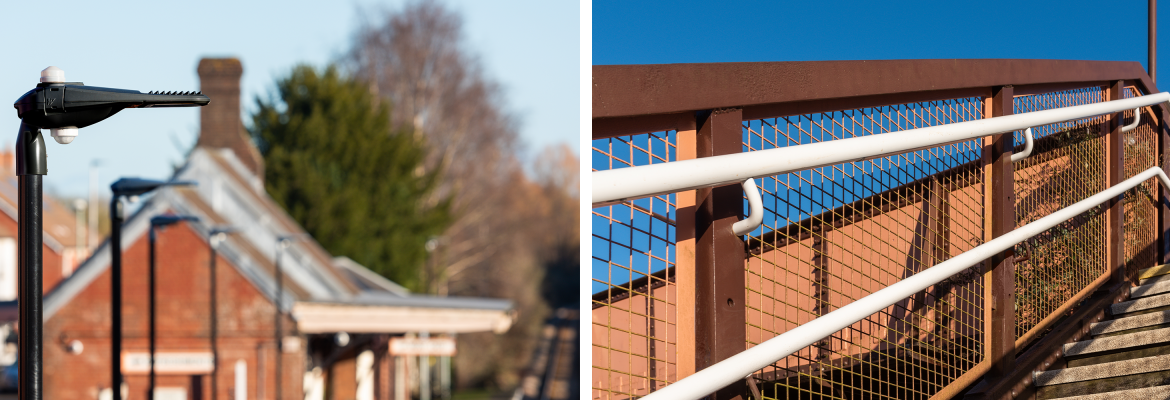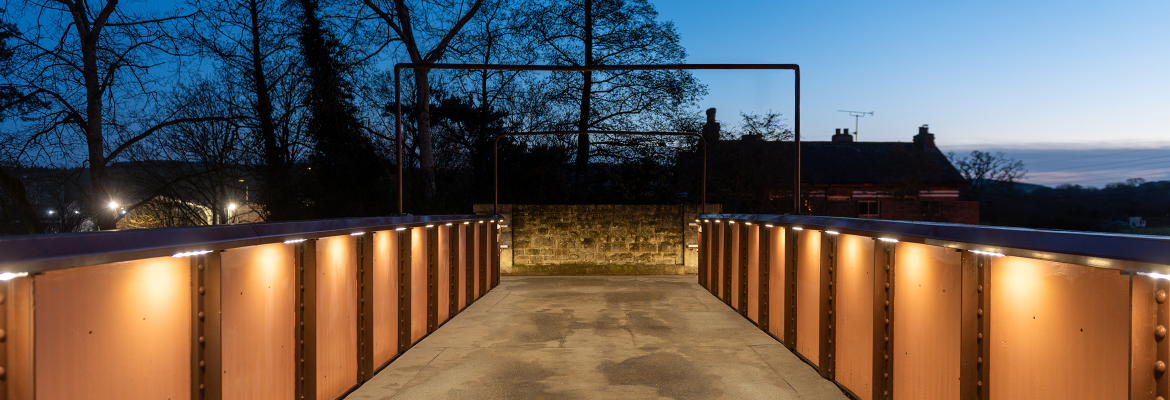Crediton Station
May 2022, by David Woodcock
May 2022, by David Woodcock
PROJECT NEWS
The UK’s rail infrastructure is currently undergoing the most ambitious upgrade programme the network has ever seen, with billions of pounds being invested into projects such as Crossrail, Thameslink, the Great North Rail Project and the wider rail electrification programme. Improving safety and the overall passenger experience is an integral aspect of the programme, and enhanced lighting design has a key role to play in this – as David Woodcock, Rail Business Unit Manager at leading British lighting manufacturer DW Windsor, explains here.
Investment in the railways continues at a rapid pace, despite the pandemic-driven reduction in passenger numbers seen in recent months. Indeed, with the Transport Secretary’s announcement in January of a further £794 million to boost the East-West Rail project, it’s clear that developing rail infrastructure is a vital part of the Government’s plans to ‘build back better’.

With numerous other projects underway across the country, the refurbishment and modernisation programme aims to deliver a more efficient rail service, placing particular emphasis on improving passenger safety and comfort. As a key component of the general station ambience, effective functional lighting certainly contributes to the physical safety of passengers by improving visibility and reducing the likelihood of trips and falls. Yet, lighting has another, more subtle, but hugely significant role to play, as it impacts passengers psychologically – instilling feelings of confidence, security and wellbeing.
In its report ‘Passenger Perceptions of Personal Security on the Railways’ (May 2016), the independent watchdog Transport Focus found that just 64% of passengers feel safe while travelling by rail after dark, compared to 98% during daylight hours. One of the key reasons given for this is a perceived lack of adequate lighting in stations and car parks. The report goes on to recommend that installing sufficient lighting is a cost-effective way to both reduce crime itself and ease passengers’ anxiety around personal safety.
It’s no surprise then that lighting designs should be centred on creating well-let, welcoming spaces – particularly in smaller, unmanned stations. However, with mounting pressure to conserve energy across all infrastructure operations, lighting spaces that may be empty of people for large stretches of time is not an efficient use of resources. While a timer-based control can go some way towards mitigating this issue, a more effective solution is to incorporate motion-sensitive lighting controls that are capable of dimming or brightening the illumination based on real-time occupancy levels.
During a recent refurbishment of Crediton Station in Devon, DW Windsor worked with SSE Enterprise Rail to deliver exactly this sort of responsive solution.
As a relatively small rural station, which is unmanned at night-time, the column-mounted luminaires along the platform (DW Windsor’s Kirium Pro 1 model) are controlled via PIR sensors, which are set to dim the lighting down to 20% output when no motion is detected after a given amount of time. Crucially, while this lower output level delivers excellent long term energy savings, it still provides enough lighting to ensure the station appears open and welcoming to passengers while deterring any potential anti-social behaviour.
Another important consideration is ensuring that station lighting plans are designed to be inclusive; supporting accessibility for all passengers regardless of ability or additional needs – this is especially important for people with visual impairments, dementia, sensory processing disorders or autistic spectrum disorders (ASD).
For example, lighting should be set at a suitable brightness for the application, to provide clear illumination without being overly harsh. Particular care should also be paid to the transitions between lighting areas, so as to avoid sharp contrasts which can be disorientating. Spot illumination should ideally be positioned at a reasonably low level and should not cause glare.
Low-level lighting is also a suitable choice for stairways and footbridges, and these high-traffic application areas require particularly careful specification. As potential hazard zones for slips and falls, it’s crucial to design the lighting in a way that minimises the risk, with current rail standards calling for 150 lux on stairs and 100 lux on overbridges. The lighting should provide adequate levels of illumination and clearly define the individual stair treads, without causing glare to train drivers – targeted functional lighting is therefore required.

However, installing fixed lighting columns is not ideal, as these can become a hazard in themselves by presenting an obstacle to the flow of foot traffic. What’s more, this is not a practical solution for retrofit projects as it can be difficult to insert new columns into these restricted spaces. On the Crediton Station project, SSE Enterprise Rail solved this problem by specifying DW Windsor’s Garda illuminated handrail. With a highly targeted output, this solution is easily able to achieve the required lighting standards for stairs and overbridges, while ensuring the illumination remains only where it is needed, with no light spilling onto the tracks.
Constructed from stainless steel or aluminium, the Garda range is a robust, long-lasting and virtually maintenance-free option, that delivers excellent energy performance. In addition, SSE Enterprise Rail selected the Garda Anti-Climb handrail on the overbridge, which features an in-built cableway that can carry power, signals and telecoms wiring – solving the problem of channelling wires from one platform to another, which can be a real challenge in retrofit projects. In addition, the patented anti-climb design prevents anyone from using the product to climb the structure and potentially gain access to the train tracks.
When it comes to lighting the platforms themselves, the focus should be on delivering uniform levels of illumination along the length of the platform, so that all objects and surfaces are clearly visible. Luminaire spacing should therefore be planned to ensure there are no pools of shadow, which can reduce visibility. Signage and platform edges must be clearly illuminated while also balancing glare – and it’s crucial that the drivers’ perspective is considered, so that they have a clear field of vision, with no obstructions to signalling.
At the Crediton Station example, DW Windsor’s Kirium Pro 1 luminaires were selected to meet this brief. Speaking about the project specification, Ben Franklin, Project Engineer at SSE Enterprise Rail, commented: “We were looking for a high-performance solution that could deliver excellent clarity of illumination in a reliable, cost-effective way. We worked closely with DW Windsor to design the lighting specification for Crediton Station and chose the Kirium Pro 1 products as they neatly fulfilled our requirements on all of these fronts. The fact that they contain in-built controls was also very appealing, as it enabled us to deliver the high-quality responsive lighting solution required by this particular application.”
With many routes now being electrified under the rail electrification programme, there is also a need for non-conductive equipment to reduce the risk of electric shock – yet it can be challenging to source suitable lighting equipment for use in these higher-risk areas. DW Windsor has developed new products to meet this need, including composite non-conductive versions of the Garda LED handrail and Kirium Bollard. These solutions are typically used for drivers’ walkways, driver hop-up platforms and access steps out on the routes and in depots and sidings.
According to the British Transport Police, for every million journeys made on the railway, only 16 crimes are recorded. The chance of becoming a victim of a crime while using the railway is therefore extremely low – yet passenger confidence can be greatly improved through careful lighting design. Effective lighting can make passengers feel safer when using underpasses or other areas where there is a fear of crime, with the use of motion-detecting controls again providing responsive illumination while avoiding unnecessary energy use.
However, vandalism is still a concern in these more secluded areas, so the chosen products need to be tough enough to withstand any possible abuse.
On the Crediton Station project, SSE Enterprise Rail also specified luminaires from DW Windsor’s Kova range, which have been designed to offer an extremely robust solution; being certified to IK10+ and achieving 150J impact resistance. Installed under the station canopies and in the platform waiting rooms on this project, the luminaires benefit from a hard-wearing anti-vandal, flame-resistant finish, as well as featuring an integral presence detection and dimming capacity, to ensure lighting supply is tailored to the required levels.
Overall, it’s clear that effective lighting can provide an important boost to both the physical and psychological safety of passengers. Careful lighting design can significantly improve the experience of travelling on the railway network – and advances in smart city technology are offering opportunities to enhance this even further. For example, network-ready LED luminaires with integrated CCTV technology such as DW Windsor’s Kirium Pro Vision can help Transport Police and service providers reduce crime and improve safety. With such a wide range of factors to consider, it’s important to partner with a lighting and connectivity supplier that is able to advise on all aspects of the design, including the necessary controls and enhanced data applications.